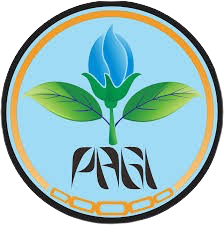Detection of Carbohydrate Compounds in Compost Made From Soybean Husk and Cow Manure
DOI:
https://doi.org/10.22219/jtcst.v3i2.29732Keywords:
GC-MS, Metabolite, Organic WasteAbstract
Husk through composting techniques. However, information about the characteristics of soybean husk still needed to be studied more deeply. This caused coagulation of primary metabolites which had a very important biological functions as an energy source, fuel and intermediates for planting, the formation of RNA and DNA structural work (ribonucleic acid and deoxyribonucleic acid), this could be used to help explore the profile carried out in soybean husk degradation. Detection of carbohydrate compounds in this study used Gas Chromatography–Mass Spectroscopy (GC–MS) because it was a powerful tool in characterizing compost. The purpose of this study was to detect carbohydrate compounds in compost made from soybean husk and cow manure. Thus, further information obtained could be used as recommendations in handling soybean husk, especially as organic fertilizer through composting techniques.The study was conducted using a Randomized Complete Block Design (RCBD) with 5 composting arrangements with five replications. Related to payments were: C1: soybean husk (100 %), C2: cow manure (100 %), C3: soybean husk: cow manure (50 %: 50 %), C4: soybean husk: cow manure (75 %: 25 %) and C5: soybean husk: cow manure (25 %: 75 %). Data were analyzed using GC–MS and Least Significant Difference (LSD). Based on analysis using GC–\MS on compost, six sugar compounds were detected. While the treatment that showed the highest area of the curve was C5 (25 % soybean husk: 75 % cow manure), this result was directly proportional to the Least Significant Difference (LSD).
Downloads
References
S. Voberkova, M.D. Vaverkova, A. Buresova, D. Adamcova, M. Vrsanska, J. Kynicky, et al., Waste Manag. 61: pp.157–164 (2017) https://doi.org/10.1016/j.wasman.2016.12.039
M. Chen, Y. Huang, H. Liu, S. Xie, and F. Abbas, J. Environ. Manage., 168: pp.200–209 (2016) https://doi.org/10.1016/j.psep.2019.03.006
B. Vandecasteele, T. Sinicco, T. D’Hose, T. Vanden Nest, and C. Mondini, J. Environ. Manage., 168: pp.200–209 (2016) https://doi.org/10.1016/j.jenvman.2015.11.045
A. Cesaro, A. Conte, V. Belgiorno, A. Siciliano, and M. Guida, J. Environ. Manage., 232: pp.264–270 (2019) https://doi.org/10.1016/j.jenvman.2018.10.121
M. Duan, Y. Zhang, B. Zhou, Z. Qin, J. Wu, Q. Wang, et al., Bioresour. Technol., 303: p.122868 (2020) https://doi.org/10.1016/j.biortech.2020.122868
T. Liu, M. Wang, M.K. Awasthi, H. Chen, S.K. Awasthi, Y. Duan, et al., J. Clean. Prod., 245 (2020) https://doi.org/10.1016/j.jclepro.2019.118894
A. Boutasknit, M. Anli, A. Tahiri, A. Raklami, M. Ait-El-Mokhtar, R. Ben-Laouane, et al., Gesunde Pflanz., 72, 3: pp.285–295 (2020) https://doi.org/10.1007/s10343-020-00511-9
X. Qian, J. Gu, W. Sun, X.J. Wang, J.Q. Su, and R. Stedfeld, J. Hazard. Mater., 344: pp.716–722 (2018) https://doi.org/10.1016/j.jhazmat.2017.11.020
J. Wu, Y. Zhao, F. Wang, X. Zhao, Q. Dang, T. Tong, et al., Bioresour. Technol., 303: p.122927 (2020) https://doi.org/10.1016/j.biortech.2020.122927
N. Rich, A. Bharti, and S. Kumar, Technol., 252: pp.83–90 (2018) https://doi.org/10.1016/j.biortech.2017.12.080
C. Ghinea and A. Leahu, Processes, 8, 3 (2020) https://doi.org/10.3390/pr8030302
P.N. Lim, T.Y. Wu, E.Y.S. Sim, and S.L. Lim, J. Sci. Food Agric., 91, 14: pp.2637–2642 (2011) https://doi.org/10.1002/jsfa.4504
S.K. Awasthi, S. Sarsaiya, M.K. Awasthi, T. Liu, J. Zhao, S. Kumar, et al., Bioresour. Technol., 299: p.122555 (2020) https://doi.org/10.1016/j.biortech.2019.122555
I. Cabezudo, M.R. Meini, C.C. Di Ponte, N. Melnichuk, C.E. Boschetti, and D. Romanini, Food Chem., 338: p.128131 (2021) https://doi.org/10.1016/j.foodchem.2020.128131
R. Abutheraa, N. Hettiarachchy, G. Kumar–Phillips, R. Horax, P. Chen, R. Morawicki, et al., J. Food Sci., 82, 3: pp.731–737 (2017) https://doi.org/10.1111/1750-3841.13644
X. Gong, S. Li, M.A. Carson, S.X. Chang, Q. Wu, L. Wang, et al., J. Environ. Manage., 248: p.109263 (2019) https://doi.org/10.1016/j.jenvman.2019.109263
V. Srivastava, S. K. Gupta, P. Singh, B. Sharma, and R. P. Singh, Int. J. Recycl. Org. Waste Agric., 7, 3: pp.241–250 (2018) https://doi.org/10.1007/s40093-018-0210-1
A. Yuvaraj, N. Karmegam, and R. Thangaraj, Ecol. Eng., 120: pp.187–197 (2018) https://doi.org/10.1016/j.ecoleng.2018.06.008
D.K. Lee, M.H. Yoon, Y.P. Kang, J. Yu, J.H. Park, J. Lee, et al.,Food Chem., 141, 4: pp. 3931–3937 (2013) https://doi.org/10.1016/j.foodchem.2013.06.064
E. Hurtado-Fernandez, T. Pacchiarotta, M. Gomez-Romero, B. Schoenmaker, R. Derks, A.M. Deelder, et al., J. Chromatogr. A, 1218, 42: pp.7723–7738 (2011) https://doi.org/10.1016/j.chroma.2011.08.059
A. Kende, D. Portwood, A. Senior, M. Earll, E. Bolygo, and M. Seymour, J. Chromatogr. A., 1217, 43: pp.6718–6723 (2010) https://doi.org/10.1016/j.chroma.2010.05.030
C.J. Gray, L.G. Migas, P.E. Barran, K. Pagel, P.H. Seeberger, C.E. Eyers, et al., J. Am. Chem. Soc., 141, 37: pp.14463–14479 (2019) https://doi.org/10.1021/jacs.9b06406
C.C. Vinson, A.P.Z. Mota, B.N. Porto, T.N. Oliveira, I. Sampaio, A.L. Lacerda, et al.,Sci. Rep., 10, 1: pp.1–19, (2020) https://doi.org/10.1038/s41598-020-72191-4
M. Sorensen, M. Penn, A. El–Mowafi, T. Storebakken, C. Chunfang, M. Overland, et al., Aquaculture, 314, 1–4: pp.145–152 (2011) https://doi.org/10.1016/j.aquaculture.2011.02.013
L. Sapir and D. Harries, J. Phys. Chem. B, 115, 4: pp.624–634 (2011) https://doi.org/10.1021/jp109780n
S. Bezrukavnikov, A. Mashaghi, R.J. van Wijk, C. Gu, L.J. Yang, Y.Q. Gao, et al., Soft Matter, 10, 37: pp.7269–7277 (2014) https://doi.org/10.1039/C4SM01532K
Downloads
Published
How to Cite
Issue
Section
License
Copyright (c) 2021 Sri Mursiani

This work is licensed under a Creative Commons Attribution-ShareAlike 4.0 International License.
Authors who publish with this journal agree to the following terms:
- Authors retain copyright and grant the journal right of first publication with the work simultaneously licensed under a Creative Commons Attribution License that allows others to share the work with an acknowledgement of the work's authorship and initial publication in this journal.
- Authors are able to enter into separate, additional contractual arrangements for the non-exclusive distribution of the journal's published version of the work (e.g., post it to an institutional repository or publish it in a book), with an acknowledgement of its initial publication in this journal.
- Authors are permitted and encouraged to post their work online (e.g., in institutional repositories or on their website) prior to and during the submission process, as it can lead to productive exchanges, as well as earlier and greater citation of published work (See The Effect of Open Access).











